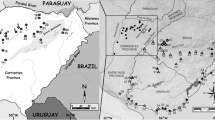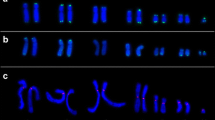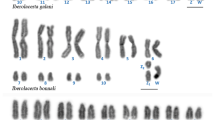Abstract
The distribution of the vertebrate telomeric sequence (TTAGGG) n in four species of armadillos (Dasypodidae, Xenarthra), i.e. Chaetophractus villosus (2n = 60), Chaetophractus vellerosus (2n = 62), Dasypus hybridus (2n = 64) and Zaedyus pichiy (2n = 62) was examined by FISH with a peptide nucleic acid (PNA) probe. Besides the expected telomeric hybridization, interstitial (centromeric) locations of the (TTAGGG)n sequence were observed in one chromosome pair of Chaetophractus vellerosus and Zaedyus pichiy, suggesting chromosome fusion of ancestral chromosomes occurring during the evolution of Dasypodidae. In addition, all the species analysed showed one to four apparently telocentric chromosomes, exhibiting only two telomeric signals. However, the immunodetection study of kinetochore proteins on synaptonemal complex spreads from C. villosus showed that the apparently telocentric chromosomes have a tiny short arm that can be resolved only in the more elongated pachytene bivalents. This finding suggests that none of the species of armadillos possess true telocentric chromosomes. Our present results support a reduction in the diploid number by fusion of acrocentrics with loss of chromosome material as a tendency in Dasypodidae.
Similar content being viewed by others
References
Blackburn EH (1991) Structure and function of telomeres. Nature 350: 569–573.
Delsuc F, Catzeflis FM, Stanhope MJ, Douzery EJP (2001) The evolution of armadillos, anteaters and sloths depicted by nuclear and mithocondrial phylogenies: implication for the status of the enigmatic fossil Eurotamandua. Proc R Soc London B 268: 1605–1615.
Delsuc F, Scally M, Madsen O (2002) Molecular phylogeny of living Xenarthrans and the impact of character and taxon sampling on the placental tree rooting. Mol Biol Evol 19: 1656–1671.
Delsuc F, Stanhope MJ, Douzery EJP (2003) Molecular systematics of armadillos (Xenarthra, Dasypodidae): contribution of maximum likelihood and Bayesian analyses of mithocondrial and nuclear genes. Mol Phyl Evol 28: 261–275.
Delsuc F, Vizcaíno SF, Douzery EJP (2004) Influence of Tertiary paleoenvironmental changes on the diversification of South American mammals: a relaxed molecular clock study within Xenarthrans. Evol Biol 4: 1–13.
Jorge W, Meritt DA, Benirschke K (1977) Chromosome studies in Edentata. Cytobios 18: 157–172.
Jorge W, Orsi-Souza AT, Best R (1985) The somatic chromosome of Xenarthra. In: Montgomery G, ed. The Evolution and Ecology of Armadillos, Sloths and Vermilinguas. Washington, London: Smithsonian Institution Press, pp 121–129.
Leitao Barroso CM, Seuanez H (1991) Chromosome studies on Dasypus, Euphractus and Cabassous (Edentata: Dasypodidae). Cytobios 68: 179–196.
Lopez MS, González Moreno MC, Casanave EB, Rahn MI, Merani MS (1997) Estudio cromosómico y variación genética intrapoblacional en Chaetophractus villosus (Dasypodidae). XII Jornadas Argentinas de Mastozoología, Mendoza, Argentina p.85 (Abstract).
Madsen O, Scally M, Douady CJ et al. (2001) Parallel adaptative radiation in two major clades of placental mammals. Nature 409: 610–614.
McClintock B (1941) The stability of broken ends of chromosomes of Zea mays. Genetics 23: 234–282.
Merani MS (2002) Variaciones citogenéticas y genéticas intra e interpoblacionales en Xenarthra. I Congreso Osvaldo Reig de Vertebradología Básica y Evolutiva e Historia y Filosofía de la Ciencia, p 52 (Abstract).
Meritt DA, Low RJ, Benirschke K (1973) The chromosomes of Zaedyus pichiy. Mammal Chrom Newslett 14: 108–109.
Meyne J, Ratliff RL, Moyzis RK (1989) Conservation of the human telomere sequence (TTAGGG) n among vertebrates. Proc Natl Acad Sci USA 86: 7049–7053.
Meyne J, Baker RJ, Hobart HH et al. (1990) Distribution of non-telomeric sites of the (TTAGGG)n telomeric sequence in vertebrate chromosomes. Chromosoma 99: 3–10.
Moyzis RK, Jones MD, Meyne J, Ratliff RL, Wu JR (1988) A highly conserved repetitive DNA sequence (TTAGGG) n present at the telomeres of human chromosomes. Proc Natl Acad Sci USA 85: 6622–6626.
Multani AS, Ozen M, Furlong CL, Zhao Y-J, Hsu TC, Pathak S (2001) Heterochromatin and interstitial telomeric DNA homology. Chromosoma 110: 214–220.
Oliveira E, Bergqvist L (1998) A new Paleocene armadillo (Mammalia, Dasypodoidea) from the Itaboraí Basin, Brazil. Paleógeno de América del Sur y de la Península Antártica, Asociación Paleontológica Argentina, Special Publication 5, 30: 3–13.
Pagliaro FE, Rahn MI, Sassaroli JC, Raspal D, Merani MS (1993) Cariotipo en dos géneros de la familia Dasypodidae. VIII Jornadas Argentinas de Mastozoología, San Carlos de Bariloche, Argentina, p. 97 (Abstract).
Patterson B, Pascual R (1972) The fossil mammal fauna of South America. In: Keast A, Eark FC, Glass B, eds. Evolution, Mammals and Southern Continents, Albany, NY: State University of New York Press, pp 247–309.
Poljak S, González P, Deferrari G et al. (2004a) Caracterización de la población del armadillo Chaetophractus villosus como exótica en la Isla Grande de Tierra del Fuego. I Congreso Nacional de Conservación de la Biodiversidad, Escobar, Buenos, Aires Libro de Actas p 114 (Abstract).
Poljak S, Lizarralde M, Merani M (2004b) Características ecológico poblacionales en tres especies de armadillos de la Prov. de Buenos Aires. I Congreso Nacional de Conservación de la Biodiversidad, Escobar, Buenos Aires Libro de Actas p 115 (Abstract).
Rahn MI, Tiranti S, Merani M (1994) Cariotipo en tres géneros de la familia Dasypodidae. IX Jornadas Argentinas de Mastozoología, Córdoba, Argentina, Libro de Actas, p 105 (Abstract).
Redi CA, Zacharias H, Merani S et al. (2005) Genome sizes in Afrotheria, Xenarthra, Euarchontoglires, and Laurasiatheria. J Hered 96: 485–493.
Sáez FA, Drets ME, Brum N (1964) The chromosomes of the mulita (Dasypus hybridus): A mammalian edentate of South America. In: Pavan C, ed. Mammalian Cytogenetics and Related Problems in Radiobiology. New York: Pergamon Press, pp 163–170.
Seabright M (1971) The use of proteolytic enzymes for the mapping of structural rearrangements in chromosomes of mammals. Chromosoma 36: 201–210.
Slijepcevic P (1998) Telomeres and mechanisms of Robertsonian fusions. Chromosoma 107: 136–140.
Sumner AT (1972) A simple technique for demosntrating centromeric heterochromatin. Exp Cell Res 75: 304–306.
Vizcaíno SF (1994) Sistemática y Anatomía de los Astegotheriini Ameghino, 1906 (nuevo rango) (Dasypodidae, Dasypodinae). Ameghiniana 30: 35–40.
Vizcaíno SF, Reguero MA, Goin FJ, Pascual R (1998) Antarctica as background for mammalian evolution. Paleógeno de América del Sur y de la Península Antártica, Asociación Paleontológica Argentina, Special Publication 5, 30: 201–211.
Wetzel RM (1985) Taxonomy and distribution of armadillos, Dasypodidae. In: Montgomery G, ed. The Evolution and Ecology of Armadillos, Sloths and Vermilinguas. Washington, London: Smithsonian Institution Press, pp 23–46.
Author information
Authors and Affiliations
Corresponding author
Rights and permissions
About this article
Cite this article
Lizarralde, M.S., Bolzán, A.D., Poljak, S. et al. Chromosomal localization of the telomeric (TTAGGG) n sequence in four species of Armadillo (Dasypodidae) from Argentina: an approach to explaining karyotype evolution in the Xenarthra. Chromosome Res 13, 777–784 (2005). https://doi.org/10.1007/s10577-005-1011-8
Received:
Accepted:
Published:
Issue Date:
DOI: https://doi.org/10.1007/s10577-005-1011-8




